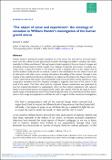Files in this item
'The object of sense and experiment' : the ontology of sensation in William Hunter's investigation of the human gravid uterus
Item metadata
| dc.contributor.author | Bellis, Richard T | |
| dc.date.accessioned | 2022-03-28T11:32:58Z | |
| dc.date.available | 2022-03-28T11:32:58Z | |
| dc.date.issued | 2022-06 | |
| dc.identifier | 278116925 | |
| dc.identifier | 3ceaf104-9cd1-4ed1-b20b-194682c47e47 | |
| dc.identifier | 35220981 | |
| dc.identifier | 000762114100001 | |
| dc.identifier | 85125852534 | |
| dc.identifier.citation | Bellis , R T 2022 , ' 'The object of sense and experiment' : the ontology of sensation in William Hunter's investigation of the human gravid uterus ' , British Journal for the History of Science , vol. 55 , no. 2 , pp. 227 - 246 . https://doi.org/10.1017/S0007087422000024 | en |
| dc.identifier.issn | 0007-0874 | |
| dc.identifier.other | ORCID: /0000-0003-1039-3138/work/158592704 | |
| dc.identifier.uri | https://hdl.handle.net/10023/25114 | |
| dc.description | Ideas present in this paper stemmed from my PhD research, which was funded by the School of Philosophy, Religion and History of Science at the University of Leeds. Further support for this research came from the Leeds Arts and Humanities Research Institute, where I enjoyed a short-term fellowship in 2021. | en |
| dc.description.abstract | William Hunter's anatomical inquiry employed all of his senses, but how did his personal experiences with the cadaver become generalized scientific knowledge teachable to students and understandable by fellow practitioners? Moving beyond a historiographical focus on Hunter's images and extending Lorraine Daston's (2008) concept of an 'ontology of scientific observation' to include non-visual senses, I argue that Hunter's work aimed to create a stabilized object of the cadaver that he and his students could perceive in common. Crucial to this stabilization was the sense of touch and its interaction with other senses, creating intersensory knowledge of the cadaver. Through a close reading of his neglected posthumous publication An Anatomical Description of the Human Gravid Uterus (1794), I demonstrate that Hunter wrote extensively about touch and other sensory experiences, using comparative metaphors and other linguistic strategies to engender clear ideas of the cadaver in the mind of the reader. That these ideas could be consistent between practitioners was guaranteed by God, but required practitioners to appropriately reflect on their sensory experiences with cadavers. Hunter's experimental practice encompassed both simple and complex methods, all aimed at increasing the range of sensorial experiences he had with the gravid uterus. His preservations of these experiences in text, image and preparation could then be used to support further anatomical investigations. | |
| dc.format.extent | 20 | |
| dc.format.extent | 512924 | |
| dc.language.iso | eng | |
| dc.relation.ispartof | British Journal for the History of Science | en |
| dc.subject | C Auxiliary Sciences of History | en |
| dc.subject | QP Physiology | en |
| dc.subject | T-NDAS | en |
| dc.subject.lcc | C | en |
| dc.subject.lcc | QP | en |
| dc.title | 'The object of sense and experiment' : the ontology of sensation in William Hunter's investigation of the human gravid uterus | en |
| dc.type | Journal article | en |
| dc.contributor.institution | University of St Andrews. School of Medicine | en |
| dc.identifier.doi | https://doi.org/10.1017/S0007087422000024 | |
| dc.description.status | Peer reviewed | en |
This item appears in the following Collection(s)
Items in the St Andrews Research Repository are protected by copyright, with all rights reserved, unless otherwise indicated.

